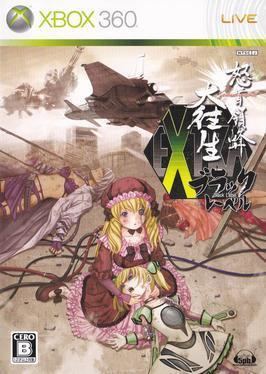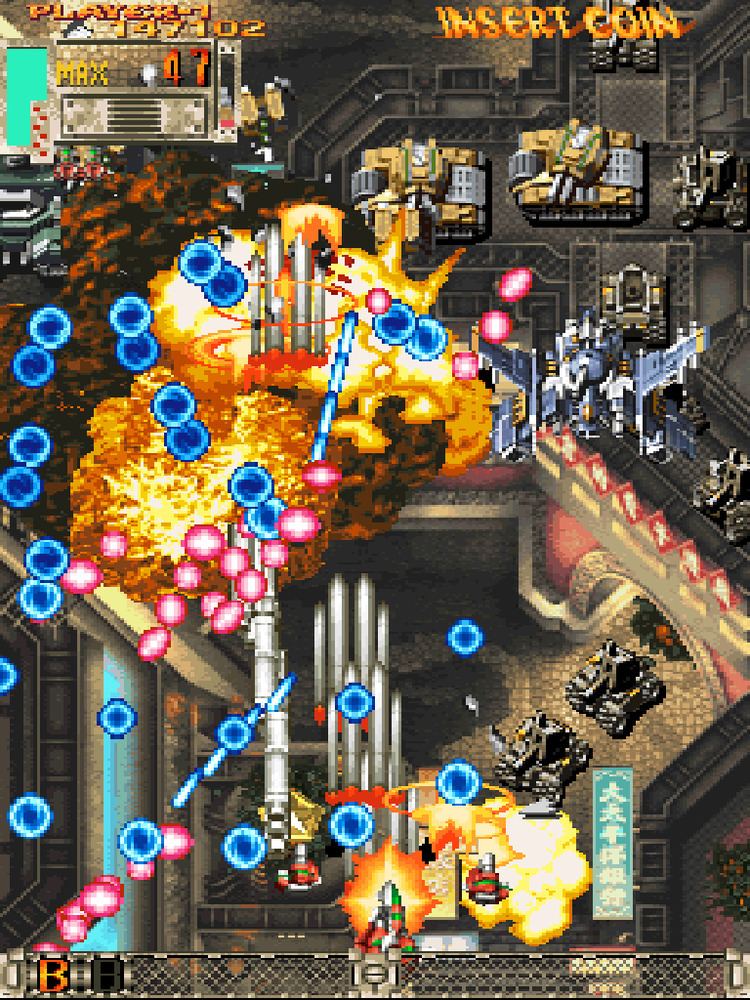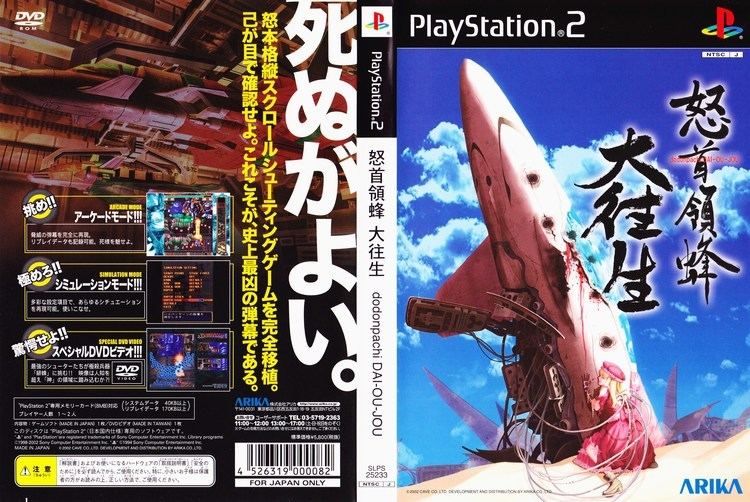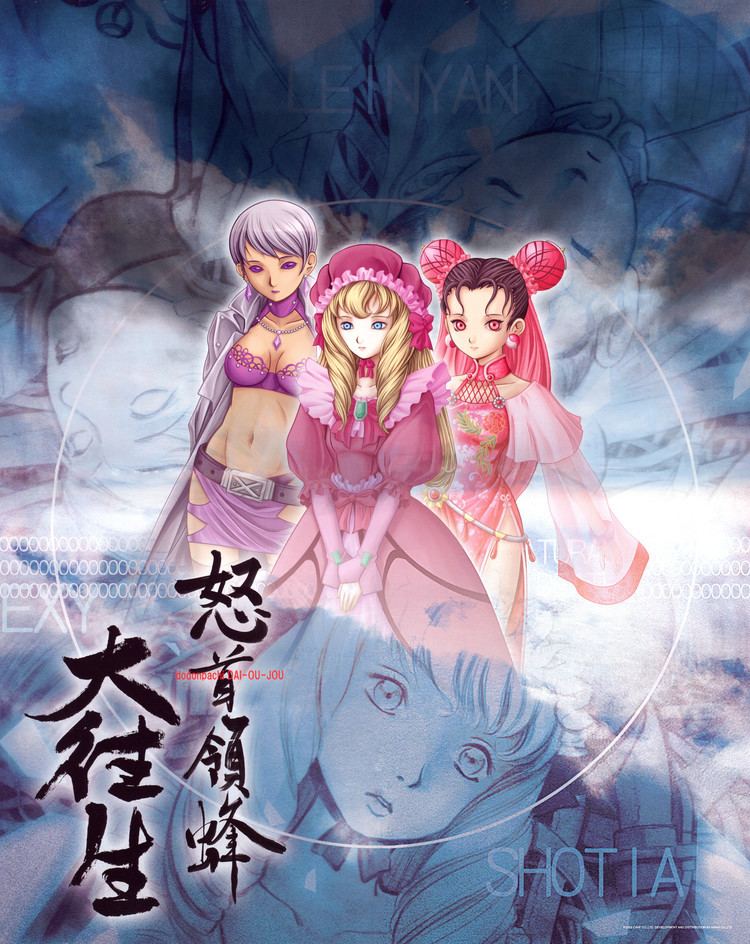9 /10 1 Votes
Cabinet Upright Initial release date 2002 Publisher Arika Developers CAVE, Arika | 4.5/5 Emuparadise Genre(s) Manic shooter | |||||||||||||||||||||||||||||||||
Release date(s) ArcadeVersion 1.01JP: April 5, 2002Black LabelJP: October 25, 2002TamashiiCH: April 20, 2010PlayStation 2JP: April 10, 2003iOS DevicesWW: February 9, 2012 Display Raster, 224 x 448 pixels (Vertical), 2304 colors Similar CAVE games, Manic shooter games, Other games | ||||||||||||||||||||||||||||||||||
Dodonpachi daioujou 1 all cave arcade pcb 2002
DoDonPachi DaiOuJou (怒首領蜂 大往生, Dodonpachi Daiōjō) is the fourth arcade game in Cave's DonPachi series. The history section of DoDonPachi DaiFukkatsu on iPhone calls it "DoDonPachi Blissful Death" in localisation; CAVE have recently announced they will release a version of the game on iOS under the localised name mentioned.
Contents
- Dodonpachi daioujou 1 all cave arcade pcb 2002
- Gameplay
- Plot
- Black Label
- Music
- PlayStation 2 release
- Mobile release
- Black Label EXTRA release
- Reception
- References

Gameplay
The controls in DaiOuJou are identical to the previous games in the series. The joystick (or controller on the PS2 version) moves the ship. Tapping button 1 fires standard shots, and holding button 1 fires the laser weapon. Pressing button 2 activates a hyper if one is available, or uses a bomb if no hypers are in stock. If the laser is active the bomb is an amplification of the laser weapon; otherwise it is an explosion that covers the screen. In all cases the player becomes invincible for a short period. There is also an option to enable button 3, which automatically fires only the standard shots, otherwise known as "auto(matic) fire".

DaiOuJou follows the conventions of the previous game with only a few changes. The chaining system is intact and works in much the same way. Causing an enemy to explode fills a meter, and every enemy destroyed before the meter depletes adds to the current chain and again refills the meter. Holding the laser weapon over a large enemy will hold the meter steady and slowly accumulate hits. In this way it is possible to create a single chain out of any of the 5 stages.

This is an addition to the series. A hyper meter is incorporated into the upper-left status display and is filled by chaining, collecting bees, and dying, amongst other things. When the meter is filled, a hyper items falls from the top of the screen, unless the player is currently in a boss battle. A player can hold up to 5 hyper items at any one time.
When hyper is activated, all hyper items are used at once with an effect proportional to the amount of hypers consumed (duration and power are both affected). A hyper causes player's fighter to be invincible for a short while, and amplifies the powers of both normal fire and the laser. Once the timer runs out the player's ship returns to normal. As a side effect, all enemy bullets move faster when the hyper is activated, increasing the "RANK" difficulty level of the game, until a bomb is used or when player's ship is destroyed. This effect does not disappear when the hyper wears off. Using a bomb during a hyper will end it immediately; dying causes player to lose all in-stock hyper items. Using hyper while there is an uncollected hyper item will transform it into a large star.
The selection of Element Dolls is similar to the selection of Shot or Laser variants in DoDonPachi. A doll is chosen after a fighter type is selected.


When the player loses a life, the revived fighter's enhanced weapon is reduced in power by one level, while the non-enhanced weapon's power is reduced to its lowest level. In the case of Expert type, both weapons are lowered by only one level upon death. Also, a player's maximum bomb capacity may be increased after respawning.
There are 5 stages per loop. The second loop becomes available if the player completes the first loop and satisfies one of the following requirements:
If the player then defeats the regular stage 2-5 boss, the true final boss of the game, Hibachi, appears.
Plot
Centuries have passed since the catastrophic war that almost cost the human race its complete annihilation at the hands of the deranged commander of the DonPachi Corps, a military squad of starfighter pilots known for their combat prowess and emotional detachment (as a result of the inhuman training they are subjected to - the first game being a prime example of it, with the trainee actually slaughtering comrades posing as the enemy); whatever remained of his genocidal army was gathered, transported to the Moon and sealed within a network of caves, left to rot away as the nightmares faded into legend.
The human race flourished again, to the point of colonizing the Moon itself, the megacity of Lunapolis being the hub of human activity on lunar soil. However, as time passed, the dormant machines reawakened, rebuilt, evolved: the underground caverns of the planet swarmed with all sorts of advanced warmachines, and automated production facilities, at their core a heavily guarded platform where the ultimate fighting machine of the past, the mechanical bee Hibachi (this time named 緋蜂, lit. "scarlet bee"), was slowly being rebuilt. Still following their original programming, the machines broke the seal, invading the surface and quickly seizing control of the almost defenseless Lunapolis, its streets and facilities now completely overtaken and littered with heavy artillery emplacements.
With little time to spare, the DonPachi Corps are reactivated, with enough time to build only two fighters; nevertheless, to each was bestowed the assistance of an Element Doll, highly evolved sentient droids (apparently widespread in human society by then, and treated as little more than slaves) capable of providing tactical data and enhancing the craft's own capabilities. Knowing that the mission is plausibly suicidal, the two attack ships are deployed on the Moon surface, just outside Lunapolis, alone against a ruthless army of machines with a single objective; killing.
The game's ending reveals, in a chilling twist, that the Element Dolls are, in truth, cybernetic beings built by forcefully turning human beings into servants, laborers and soldiers, their minds and wills rewritten and bent to the whim of Earth's upper class. Then, a Doll-specific coda is shown:
Black Label
This variant was a limited edition release. The arcade board includes the original and Black Label games, which can be selected during boot time. The Black Label game can be identified by the black title screen. After the release of the Black label, the original version is called as White Label, particularly for clarification.
Changes in Black Label include:
Music
The music tracks are puns of shooting game companies. Mukei, Toua, Takimi, Torejya, Saikyou, Seibu, Sakusetsu, Taitou, Raijin, and Awaremu are named after NMK, Toaplan, Takumi Corporation, Treasure, Psikyo, Seibu Kaihatsu, Success Corporation, Taito Corporation, 8ing/Raizing, and Irem respectively.
As often pointed out by fans, Manabu Namiki confirmed that the tracks from the game are the shooting game companies stated above he wanted to show respect for.
PlayStation 2 release
This version added the following modes/features:
Death Label mode sets the player against a boss rush, with maximum firepower at all times and a full stock of Hyper granted before each boss. Death Label's difficulty is roughly equivalent to that of the normal game's second loop, with a number of alterations made to the bosses and their attack pattern. The most notable change is made at the final boss fight of Death Label, where the player faces two Hibachis simultaneously. According to top players, this is the hardest iteration in the DoDonPachi series taking 7 years (from 2003 until 2010-09-18) to clear.
Mobile release
This edition is aimed at Taiwan-Chinese market and some in-game text are translated in Chinese. It features an easy mode for beginners (not Black Label). Published by IGS on April 20, 2010.
Black Label EXTRA release
The 2008-03-07 issue of Famitsu Weekly magazine reported that 5pb.Inc.'s 5pb.Games Division #2 would bring this game to the Xbox 360 platform as an Xbox Live Arcade title. However, 5pb representative Masaki Sakari claimed that Microsoft rejected 5pb's proposals and 'decided to cut down faithful arcade ports.'. 5pb considered releasing Black Label and Ketsui on a retail DVD instead.
On 2008-09-26, Famitsu announced the official title of the Xbox 360 version of the game, dodonpachi DAI-OU-JOU Black Label EXTRA (怒首領蜂 大往生 ブラックレーベル EXTRA), scheduled for a release on Christmas Day of 2008. The port includes the original and Black Label editions of the game, as well as online score ranking, replay saving, enhanced graphics, and Xbox Live Marketplace content. There is an Xbox 360 original mode for beginners named the "X Mode", where a new Element Doll named Piper is introduced.
The pre-order also includes a guidebook.
Arcade mode - Old Version - is a port of the original "White Label" arcade release.
Arcade mode - New Version - is a port of the newer "Black Label" arcade release.
The X Mode features a 1 loop, 5 stage layout with a new game system.
The game's music can be changed from Mono (from arcade), Stereo, or X Mode, which features rearranged music.
Xbox achievements feature 50 categories for 1000 points total.
Player can get extra credits, X mode, and unlock Config EX options that alter game play mechanics by playing the game for a specific amount of time or earning achievement points.
The Xbox 360 version was plagued at released with bugs and problems that rendered the game highly inaccurate and glitchy. It was eventually found that 5pb had, without permission, lifted the source code from the PS2 version of the game and slotted it in for the 360 version while making adjustments as needed. Patches were eventually made with Cave and Microsoft stepping in to aid the patching process.
Reception
Famitsu Scored the PlayStation 2 release a 34/40 and the Xbox 360 release a 27/40.
